Join More Than 50,000+ Subscribers and get latest camera news and rumors
NEW CAMERA VIDEOS ON YOUTUBE
|
By admin, on May 4th, 2025
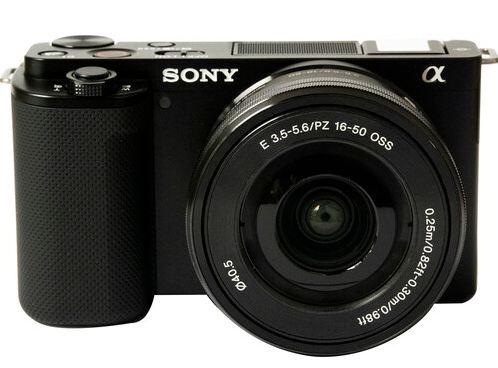
Sony ZV10 is a powerhouse camera for Vloggers and photographers as well and content creators. The camera features a 24-megapixel APS-C BSI CMOS sensor and the ability to record 4K video, a lot of new features, along with E-mount support. But to unlock its full potential, you have to use the right lens when you are shooting cinematic vlogs or portraits, or vibrant travel photos. Choosing the best lenses for the Sony ZV10 in 2025 will make a real difference. In this guide, we have tested out several lenses and being using the ZV10 camera for more than 2 years we have selected the top best lenses for every use case from wide-angle prime lenses to versatile zoom lens with the detailed review and some sort of comparison tables we have below, you will get the best available lens for the ZV-E10 camera.
Table of Contents
Why does the right lens matter?
Best prime lens for Sony ZV-R10
Best zoom lens for Sony ZV-E10
Best budget lenses for Sony ZV-E10
Comparison table
How to choose a lens for your Sony ZV-E10
FAQ
Why does the right lens matter?
Sony ZV-E10 camera and its successor, Sony ZV10 II, are designed for content creators, specifically those who want the highest quality output possible without sacrificing quality. The Sony 24-megapixel BSI CMOS sensor delivers excellent, crisp, and clear oversampled 4K video footage, but the lens that you pair with the camera determines the overall output of your content. A wide-angle prime lens is ideal for vlogging with the camera, and a versatile zoom lens covers multiple scenarios. I am using the Sony ZV-E10 camera in my creator studio for more than 2 years and also it is one of my primaries for photography also, so the lenses that we have mentioned below are being tested in real-world conditions and if you are blogging in a street, shooting landscape images or capturing portraits these lenses will help you to get the maximum output from your camera.
Best Prime Lenses for Sony ZV-E10
Prime lenses offer unmatched sharpness, low-light performance, and background blur, which is not possible with zoom lenses. So for vlogging purposes, for portraits, and also for cinematic shots, here are our top picks:
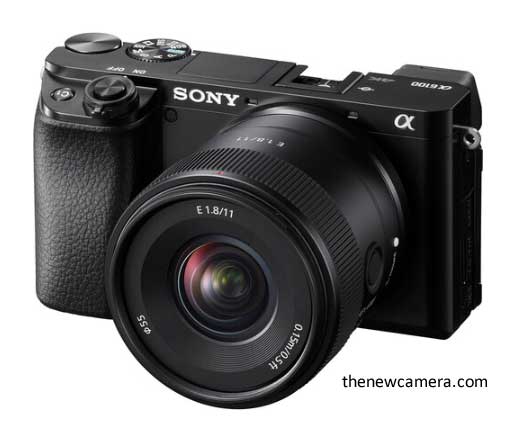
Best Ultra-Wide Vlogging Lens for Travel Vloggers
1. Sony 11mm f/1.8
- Specs: 11mm focal length (16.5mm equivalent), f/1.8 aperture, 181g, no OSS, 55mm filter.
- Price: ~$550 (Check Price at B&H Store and Amazon.com).
Sony 11mm f/1.8 is the best lens for Sony ZV-E10 vloggers, those who need maximum coverage of the frame. The 11mm lens is highly required, which will act as a 16.5mm lens in 35mm format, making it very ideal for handheld vlogs and for dramatic indoor and landscape. The Sony silent dual linear autofocus motor always keeps tracking the subject without any issue. The lens is very lightweight with 181 grams and pairs up perfectly for ZV-E10 and handheld vlog shooting.
- Pros:
- Ultra-wide for maximum scene coverage.
- Fast f/1.8 aperture for low-light and bokeh.
- Lightweight and weather-sealed.
- Cons:
- No optical stabilization (use ZV-E10’s digital IS).
- Some edge distortion (correctable in post).
Best For: Vloggers needing wide coverage, travel creators, and architecture photographers.
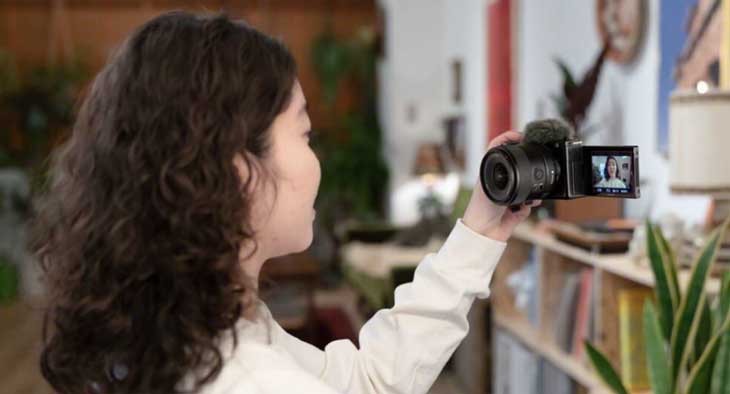
Now, if you want a super-low-light-sensitive ultra-wide lens, then we have the Viltrox 13mm F1.4
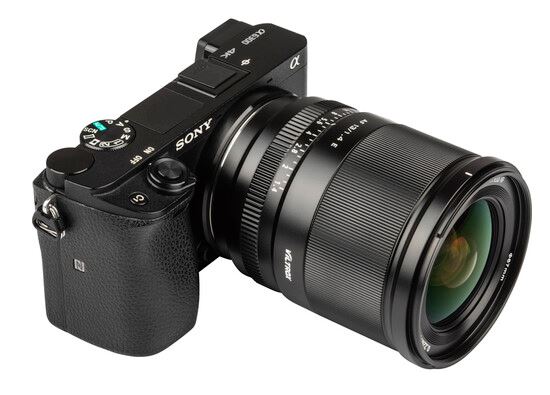
2. Viltrox 13mm F1.4 Lens: The Viltrox 13mm F1.4: If you are a content creator who creates most of your videos in an office or home setting, then you should consider the 16mm F1.4 lens. However, if you want extra coverage of your surroundings, for example, if you want a super-wide view or if you want to capture everything around you, especially for travel bloggers who want a bit more coverage than normal, then in that specific situation, I would suggest you go with the Viltrox 13mm F1.4 lens for the E-mount.
In terms of build quality, the lens is made up of a solid metal casing and has multiple weather seals, which makes it perfect to carry around in adverse weather conditions. The cherry on top is that you get a large manual focus ring which you can easily use to provide a smooth focusing experience. You can also do manual override while using autofocus.
The lens features an F1.4 aperture which makes it an ideal ultra-wide-angle prime lens to capture videos and even images in extremely low light conditions. The lens can also be used for astrophotography due to the nature of its high-grade optics.
A lot of effort has been put into optimizing this lens to perform perfectly while shooting videos. The lens features an STM motor, also known as a stepping drive motor, which helps to focus quickly without creating any noise.
Check the Latest Price of Viltrox 13mm F1.4 lens at Amazon | B&H Store
Pros:
- Impressive performance
- Solid metal casing
- Good handling
- Fast and accurate autofocus
- Affordable
Cons:
- No AF/MF focus mode switch
If you are a travel blogger and want to have super-wide coverage with a 13mm lens, you can go with this one
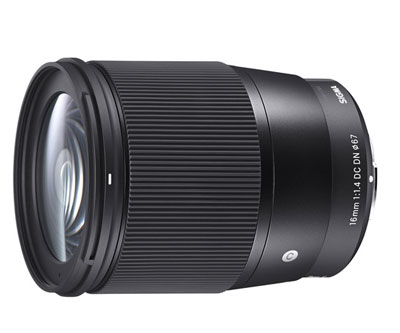
3. Sigma 16mm f/1.4 is a top choice for vlogging with a slightly tighter frame than the Sony 11mm.. The prime is designed for APS-C-format Sony E-mount mirrorless cameras and provides a 24mm equivalent focal length. A perfect focal length for creating content by putting ur camera just 2 to 3 feet away, and yes u can sometimes do handheld vlogs too.
The best part of the lens is the F1.4 aperture. Bright f/1.4 maximum aperture excels in low-light conditions. Shooting at Night and creating nightlife vlogs is now very easy with F1.4 aperture. And as usual, it also affords increased control over depth of field for achieving selective focus effects.
The AF is very fast, and the Sigma uses a stepping AF motor optimized for both photographers and videographers with its fast, precise, and near-silent performance.
The lens is an amazing bargain – super sharp, very fast, beautiful bokeh, and auto-focus. There is pretty much nothing not to like. The construction is rock solid, and rubber sealing is incorporated in the mount design to render it dust- and splash-resistant.
- Pros:
- Sharp at f/1.4.
- Compact for a fast prime.
- Affordable for the performance.
- Cons:
- No optical stabilization (use ZV-E10’s digital IS).
- Slightly heavy for long handheld shoots.
- Best For: Vloggers, low-light shooters, and travel creators.
- Price of Sigma 16mm F1.4 – Buy this lens from Amazon.com | B&H Store
Sample: View sample vlog shot with Sigma 16mm.
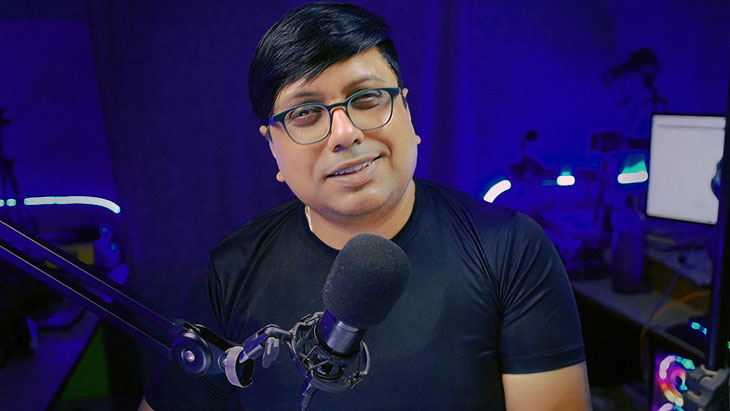
The Sigma 16mm F1.4 lens is an excellent companion for the Sony ZV-E10 Camera, specifically when you want to keep the camera very close to you, the lens genrates the best output.
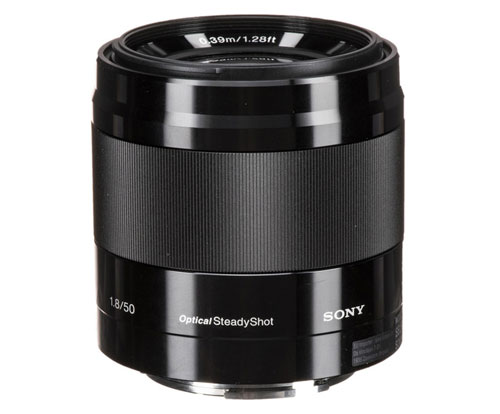
4. Best Budget portrait Prime Lens for Sony ZV-E10 – Sony 50mm F1.8 – The best portrait prime lens ever made for Sony APS-C Mirrorless cameras. The lens features Optical SteadyShot image stabilization, so you can get sharper imagery when shooting handheld with slower shutter speeds. The OSS helps really a lot while shooting in low-ligh conditions.
One of the only portrait prime lens that features built-in OSS
An internal focus mechanism is really fast and responsive, with a minimum focus distance of 1.3′, and easier handling as the lens does not change in length during use. So, you can use this lens very easily with gimbals also.
The only downside, this lens isn’t weather-sealed, but also keep in mind the lens is made for an APS-C Mirrorless camera and not a Full frame camera. If you use it with a camera like Sony A7 III, the camera will work in DX mode and you will get a 10MP file.
Best zoom lens for Sony ZV-E10
Now here is the list of Best Zoom Lenses for the Sony ZV-E10 camera, that will help you extract the best possible output from ZV-E10’s 24MP BSI CMOS sensor.
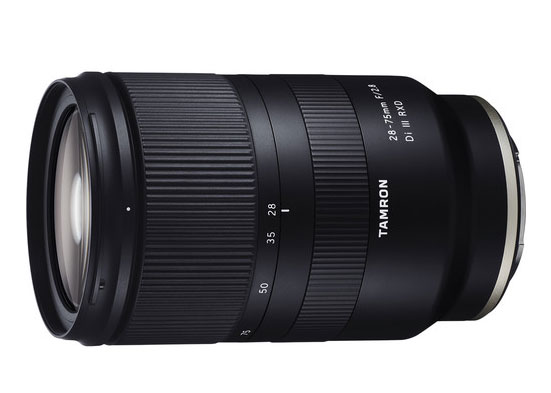
1. Tamron 17-70mm F2.8 RXD – At $799 you are getting a pro lens, Tamron 17-70mm f/2.8 Di III-A VC RXD is a 25.5-105mm-equivalent lens for APS-C-format Sony E-mount mirrorless cameras. It’s an engineering masterpiece, incredibly versatile everyday zoom ideal for everyday shooting, and the fast f/2.8 constant maximum aperture suits working in difficult lighting conditions and offer improved control over depth of field. This lens delivers outstanding image quality even when shooting wide open, it is beautifully sharp throughout the frame.
The lens features built-in IS, which helps you to shoot with slower shutter speeds in low-light conditions without adding any motion blur or camera shake to your image. Altought the F2.8 aperture helps a lot while shooting in low-light.
Autofocus is very fast, accurate, and silent. For video users, there is almost no focus breathing throughout the range and focus pulls look incredible. VC of course makes handheld shots very smooth. And the controls on the lens are very smooth and do allow you to rather cleanly zoom in and out.
Buy Tamron 17-70mm F2.8 Lens fro m Amazon.com | B&H Store
This lens is awesome. For many shooters and videographers, this could be a one-and-done lens. The only downside, there are no physical controls on this lens for stabilization or focus modes, so you’ll have to change them through the menu system in your camera.
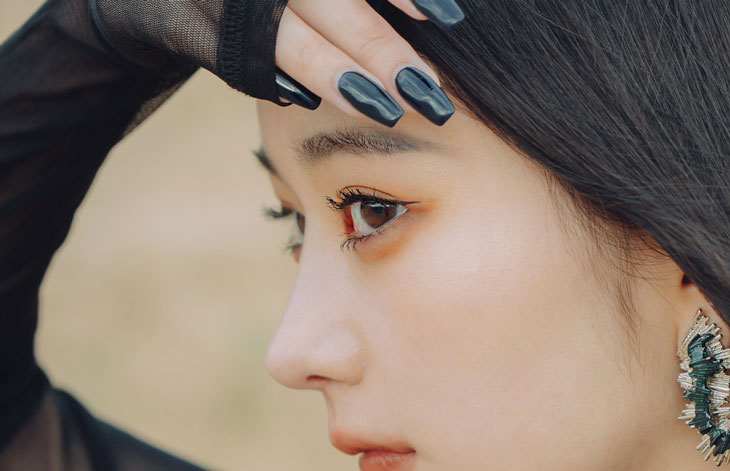
Now let’s talk about a lens with an extra wide coverage and a constant F2.8 aperture
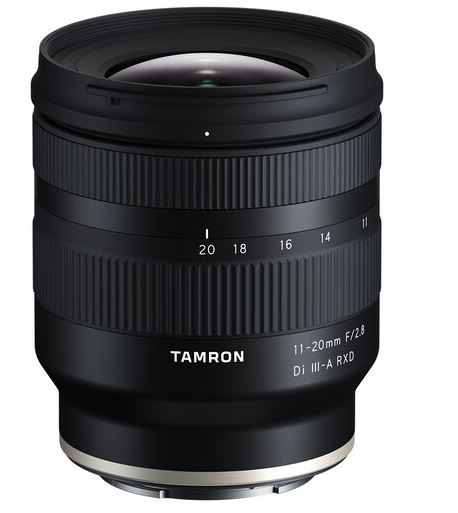
2. The Tamron 11-20mm F2.8 is an APS-C lens with a constant F2.8 aperture. This lens is designed for content creators, covering a vital range from 11mm to 20mm. It can go super wide and then up to a normal wide mode which is 20mm. So, if you want to cover the entire environment, you can adjust the lens up to 11mm and depending on your set of requirements and taste, you can adjust its focal length. It’s not a prime lens, so you don’t have to worry about buying a 13mm lens or 16mm lens. It covers from 11mm to 20mm with a constant F2.8 aperture and is built with RXD motors, so the autofocus is super fast and silent.
The lens features a steel construction and lightweight design, so you don’t have to worry about handling it for a long time. You can also use this lens in adverse weather conditions.
rock-solid in the hands and features a dust- and splash-resistant design. An excellent lens for outdoors.
Quick Guide
| Lens Name |
OIS |
Weight |
Price |
Best Use Case |
| Sony E 11mm f/1.8 |
No |
181g |
$550 |
Lightweight / Vlogging/Wide Coverage |
| Viltrox AF 13mm f/1.4 |
No |
420g |
$430 |
Low-Light Vlogging / Wide Coverage |
| Sigma 16mm f/1.4 |
No |
405g |
$400 |
Vlogging/Low-Light |
| Sony E 35mm f/1.8 |
Yes |
54g |
$450 |
Portraits/Street |
| Tamron 17-70mm f/2.8 |
Yes |
525g |
$800 |
All-Purpose/Travel / Wedding / Event |
| Sony E PZ 10-20mm f/4 |
No |
178g |
$750 |
Wide-Angle Vlogs |
| Sony E 50mm f/1.8 |
Yes |
202g |
$300 |
Portraits/Budget |
| Tamron 11-20mm f/2.8 |
No |
335g |
$500 |
Budget Vlogging / Street Food / Travel |
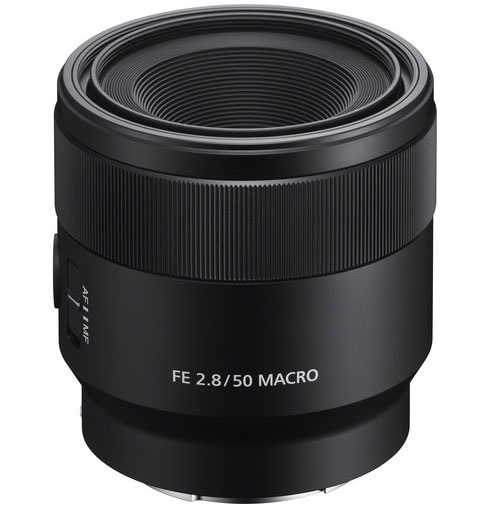
Best Macro Lens
Sony FE 50mm F2.8 Macro G OSS is designed for full-frame E-mount cameras, this telephoto macro can also be used on APS-C systems, where it provides a 75mm equivalent focal length. The lens is affordable and perfect for APS-C Mirrorless cameras, this is a true 1:1 Macro Lens so you will be getting life-size images from the lens. Later on, once you have upgraded you can use this lens on the A7 series camera too.
Get 50mm F2.8 Macro Lens from Amazon.com | B&H Store
The true macro design affords a life-size, 1:1 magnification ratio along with a 6.3″ minimum focusing distance for working with close-up subjects. A focusing distance and magnification scale are also printed on the top of the lens to aid in more technical applications.
One extra-low dispersion element is featured in the lens design and helps to reduce chromatic aberrations and color fringing for improved clarity and color neutrality.
Best telephoto zoom
One of the best investments for APS-C users, it is a full-frame Tamron 70-180mm F2.8 VXD G2 lens so you will get a 105-270mm equivalent focal length range. The best lens when you do have some flans of getting a Sony full-frame camera.sue to fast aperture and being a full-frame lens the overall quality of this lens is just amazing.
Bright constant f/2.8 maximum aperture affords consistent brightness throughout the zoom range and offers improved control over depth of field. Two VXD (Voice-coil eXtreme-torque Drive) linear motors deliver impressively quiet, quick, and precise focusing performance to suit both stills and video applications. This focusing system offers a minimum focusing distance of 2.8′ at all focal lengths, and a 1:4.6 maximum magnification at the 180mm focal length for working with close-up subjects. Full-time manual focus override is also possible, and it is compatible with Sony’s Direct Manual Focus function or fine-tuned manual control.
We highly recommend you tet the Tamron 70-180mm lens, so will get max output from your camera, and later on ,you can use this lens for your future full-frame cameras.
How to choose the right lens for your Sony ZV-E10 camera?
See choosing the right lens actually depends on one’s shooting style, the set of requirements you have and your budget. All these factors decide the best lens for you.
1. Finding out the right focal length
Ultra wide lenses (10-15mm)
The lenses falling in the range of 10 to 15 mm are the best lenses for vlogging. These lenses provide maximum coverage even in tight spaces and some of the examples are Sony 11 mm f/1.8 and the Viltrox 13mm f/1.4.
Wide Angle lenses from 16 to 20 mm
16 to 20 mm lenses are highly suitable for desk vlogs. When you want to keep your camera really close to yourself, just after the screen of your desktop, then having lenses like Sigma 16 mm f/1.4 is really usable. Occasionally, you can also do handheld vlogging.
Standard lenses from 24 to 50 mm
The standard lenses need a good working distance from the subject. So, if you are sitting in a room or office and your camera is at a good distance from you, then you can use lenses like 35 mm from Viltrox or Sony, or a 56 mm lens from Sigma, or a 50 mm lens from Sony—any of these. So it all depends on how far you’re sitting from your camera.
Telephoto / Zoom lenses 70 mm+
If you are interested in sports and wildlife—which is really very less common with ZV-E10 users—then you have to invest in 70 mm+ lenses. Otherwise, most of the work can be done easily with lenses below this focal length.
2. Aperture
Fast aperture lenses with f/1.4 to 2.8 range
For better low light performance and shallow depth of field, you will need lenses with bright or max aperture value f/1.4—like we have the Viltrox 13 mm f/1.4 or the Sigma 16 mm f/1.4. Now just after that, we have f/1.8 lenses like the Sony 11 mm f/1.8.
Slower aperture f/4+ focal length
The f/4 or f/4+ lenses are more budget friendly but less effective in low light scenarios.
3. Optical Image Stabilization (OIS)
Since the camera does not have any sensor-shift image stabilization, it’s very important to select lenses with OIS (Optical Image Stabilization) if available. Otherwise, you have to use your camera on a gimbal to get highly stable output. Aur as a content creator, you can also use the camera’s gyro-based image stabilization, which is very effective.
4. Budget-friendly lenses
Under $500 lenses: If you are really looking for budget-friendly lenses, then I will recommend you to get Viltrox Air Series lenses. Even some lenses that we have recommended here like 50 mm f/1.8, Viltrox 30 mm f/1.4 and Tamron 11-20mm f/2.8 are some budget-friendly lenses.
Budget range $500 to $1000: Higher priced lenses include Sony 11 mm f/1.8 and Tamron 17-70 mm f/2.8.
Practical tips
Vlogging with coverage: Choose an extra wide-angle lens while you are vlogging, like Sony 11 mm or at least Viltrox 13 mm. With the extra coverage, you can easily apply Active IS stabilization that will do a digital fine crop. As well as, you can also apply gyro-based image stabilization. These extra wide-angle lenses help a lot when you want to implement digital zoom in your camera or in your software.
Low light vlogging: Ultra-bright lenses like—for vlogging purpose—you can have the Viltrox 13 mm f/1.4 or you can also have the Sigma 16 mm f/1.4. When you are shooting in your room or in your bedroom, these f/1.4 lenses are really very helpful when you are shooting in available light.
Portraits: For getting excellent results, I will highly recommend you to get 50 mm f/1.8 or 56 mm f/1.4 lens.
Travel Lens: The Tamron 17-70 mm covers most of the scenarios.
FAQ
What is the best lens for Sony ZV-E10 vlogging?
The Sony 11 mm f/1.8 is our top pick for vlogging. The lens covers an ultra-wide range of 16.5 mm in terms of full-frame equivalence. A perfect lens that covers the entire environment along with you, and also helps you to implement Active IS without any significant loss of frame. The second-best alternative to 11 mm f/1.8 is the Viltrox 13 mm f/1.4 which actually shines with its ultra-bright f/1.4 aperture—best for low-light scenarios.
Can I use full-frame lenses on the Sony ZV-E10?
You can use Sony E-mount full-frame lenses, as those are compatible with the ZV-E10 camera, but as we all know, the Sony ZV-E10 uses an APS-C CMOS sensor. For example, a 24mm lens will act as a 36mm lens on your camera, and the advantage of getting a crop lens is the size of the lens, like we have the Viltrox 13mm f/1.4, which is lighter as well as cheaper in its category.
What’s the best budget lens for Sony ZV-E10?
The Sony 50mm f/1.8 is the best budget lens for capturing portraits. The next best lens to it is the Viltrox Air 35mm f/1.8. Such lenses are lighter and cheaper for the ZV-E10 camera.
Do I need stabilisation for ZV-E10 in lenses?
Stabilisation, either mechanical or electronic, is needed for handheld vlogging. Now, if you are using a gimbal, which of course makes your setup a bit heavy, then you are getting very clean and smooth footage. But if you are not using any gimbal, then it’s highly recommended to use either Active Image Stabilisation mode inside your camera or completely turn off all the in-camera modes and later stabilise your footage in the Catalyst Browse software provided free by Sony.
Which is the best lens for low-light photography or vlogging?
The Viltrox 13mm f/1.4 is the best or the top choice for low light. These lenses maximise light capture and create a very creamy background blur. So, for available light, these two are the best lenses. Now, if you want a lightweight solution that’s easy to carry all the time, then with a bit of sacrifice, you can have the Sony 11mm f/1.8.
Are third-party lenses like Viltrox or Sigma good for the Sony ZV-E10?
Yes, third-party lenses like Viltrox and Sigma or even Tamron have the same autofocus algorithm inside them, which is being provided by Sony itself to the third-party lens makers. And the best part is that they give the best performance at lower prices. Like we have the Viltrox 13mm f/1.4 and the Sigma 16mm f/1.4, which are prime examples of lenses offering the surface-level optics with fast autofocus and great value for content creators and vloggers.
ABout the author: The article “Best Lenses for Sony ZV-E10 in 2025: Top Picks for Vlogging & Photography” written and updated by thenewcamera.com team on 5:50 am Monday, 5 May 2025 Greenwich Mean Time (GMT) | Follow us for more updates and Get LIVE RUMORS –> FACEBOOK | TWITTER | INSTAGRAM to get live news — > –>see more Sony Alpha Rumor
By admin, on March 26th, 2025

Let’s compare the specifications of the Canon R50V and Sony ZV-E10 cameras. We are also focusing on their video graphics features. Both specifications are up to date as of March 26, 2025. Enjoy the specs comparison between the two.
Specification Comparison Table: Canon R50V vs Sony ZV-E10
| Category |
Canon R50V |
Sony ZV-E10 |
| Release Date |
March 26, 2025 |
July 27, 2021 |
| Sensor |
24MP APS-C CMOS |
24.2MP APS-C Exmor CMOS |
| Processor |
DIGIC X |
BIONZ X |
| Lens Mount |
Canon RF-S (compatible with RF lenses) |
Sony E-mount |
| Native ISO Range |
ISO 100-32,000, extendable to 51,200 |
ISO 100-32,000 (expandable to 50-51,200) |
Video Specifications
| Feature |
Canon R50V |
Sony ZV-E10 |
| Max Video Resolution |
4K 60p (cropped), 4K 23.98p (assumed uncropped based on preview footage) |
4K 30p (1.23x crop), 4K 24p (uncropped, oversampled from 6K) |
| Full HD Capabilities |
1080p up to 120p (implied from slow-motion options) |
1080p up to 120p |
| Video Codecs |
H.265, H.264 (10-bit 4:2:2) |
XAVC S (H.264, 8-bit 4:2:0) |
| Color Profiles |
C-Log3, custom picture profiles from Canon cinema series |
S-Log2, S-Log3, HLG |
| Internal Recording |
10-bit internal recording with C log |
8-bit internal recording S Log |
| Streaming |
4K 30p via USB-C (dedicated quick streaming button) |
720p via USB-C (requires software setup, no 4K streaming natively) |
| Slow Motion |
1080 120p Supported with option to bake in or exclude audio (specific frame rates not detailed) |
1080p 120p (no audio baking options specified) |
| Recording Limit |
Not specified / No limit |
No recording time limit |
| Autofocus in Video |
Dual Pixel AF II (fast, reliable tracking, eye detection) |
Fast Hybrid AF with Real-time Eye AF, Tracking, Product Showcase mode |
| Stabilization |
No IBIS, relies on lens IS (e.g., 14-30mm PZ) or digital stabilization (crops further) |
No IBIS, Active SteadyShot (digital, ~1.44x crop in Active mode), lens OSS support |
| Cinematic Features |
“Peter McKinnon mode” (baked-in cinematic bars) |
No SCinetone mode |
Audio Specifications
| Feature |
Canon R50V |
Sony ZV-E10 |
| Microphone Port |
Yes (3.5mm) |
Yes (3.5mm) |
| Headphone Port |
Yes (3.5mm) |
Yes (3.5mm) |
| Onboard Microphone |
Standard stereo mic (not emphasized as vlogging-specific) |
Directional 3-capsule mic with windscreen (optimized for vlogging) |
| Digital Audio Support |
Digital hot shoe (24-bit, 4-channel audio with compatible Canon mics) |
Multi-interface shoe (digital audio with compatible Sony mics) |
Body Design
| Feature |
Canon R50V |
Sony ZV-E10 |
| Dimensions |
116 x 86 x 69 mm |
115 x 64 x 45 mm |
| Weight |
~375g with battery |
343g (with battery and SD card) |
| Viewfinder |
None (EVF omitted to reduce cost) |
None |
| Screen |
3-inch vari-angle LCD 1.04 Mdot |
3-inch fully articulated LCD (921k dots) |
| Tally Light |
Yes (front-facing, with red box on screen) |
Yes (red tally light on front) |
| Vertical Video Support |
Quarter-20 mount on side for vertical tripod/gimbal use |
No dedicated vertical mount |
| Weather Sealing |
None |
None |
| Ergonomics |
Compact, lightweight, minimal grip |
Compact, lightweight, minimal grip |
Ports and Connectivity
| Feature |
Canon R50V |
Sony ZV-E10 |
| USB |
USB-C (supports streaming and charging) |
USB-C (supports streaming and charging) |
| HDMI |
Micro HDMI |
Micro HDMI |
| Microphone Port |
Yes (3.5mm) |
Yes (3.5mm) |
| Headphone Port |
Yes (3.5mm) |
Yes (3.5mm) |
| Remote Port |
Yes (2.5mm) |
No |
| Hot Shoe |
Digital hot shoe (24-bit, 4-channel audio support) |
Multi-interface shoe (digital audio support) |
| Wireless |
Wi-Fi 5 |
Wi-Fi (2.4 GHz), Bluetooth 4.1 |
Battery and Storage
| Feature |
Canon R50V |
Sony ZV-E10 |
| Battery Type |
LP-E17 |
NP-FW50 |
| Battery Life (CIPA) |
270 shots per charge |
440 shots |
| Charging |
USB-C charging supported |
USB-C charging supported |
| Storage |
Single SD slot UHS-II |
Single SD slot UHS-I |
Still Photography
| Feature |
Canon R50V |
Sony ZV-E10 |
| Resolution |
24MP |
24.2MP |
| Burst Shooting |
15 fps (electronic), 12 fps (electronic first curtain) |
11 fps (mechanical/electronic) |
| RAW Support |
Yes |
Yes |
| Image Stabilization |
None (lens-based only) |
None (lens-based only) |
Price and Kit Options
| Feature |
Canon R50V |
Sony ZV-E10 |
| Body Only |
$649 |
$699 |
| Kit Option |
$849 with RF-S 14-30mm f/4-6.3 PZ IS STM (22-48mm equiv.) |
$799 with E PZ 16-50mm f/3.5-5.6 OSS (24-75mm equiv.) |
| Lens Ecosystem |
RF-S (limited native APS-C lenses, full RF compatibility) |
E-mount (extensive native APS-C and full-frame options, third-party support) |
Additional Features
| Feature |
Canon R50V |
Sony ZV-E10 |
| Vlogging Features |
Tally light, vertical mount, quick streaming button, cinematic bars, Canon’s own product showcase mode, and many new features |
Product Showcase mode, Background Defocus button, directional mic |
| Customizability |
Custom picture profiles from the cinema series |
SCinetone Missing |
| Firmware Updates |
Not applicable yet (preview model) |
Regular updates (e.g., improved streaming with firmware v2.00) |
Conclusion: Canon R50V vs Sony ZV-E10
The Canon R50 V camera features updated video recording capability, including 10-bit 4:2:2 internal recording and 4K video recording up to 60 frames per second (1.5x crop). However, the Sony ZV-E10 remains limited to 8-bit, and 60 FPS 4K mode is unavailable. Even in the live streaming option, the Canon R50 V can live stream up to 4K 60 FPS. Additionally, in the body, you get a vertical mount to record vertical videos for YouTube Shorts, Instagram, or other media networks.
The only reason Sony excels now is the vast lens found in the E-mount. We have a range of options, and nowadays, even Viltrox Air series lenses are available at very affordable prices and can be easily purchased for the Sony ZV-E10 camera. On the other side, in Canon R50 V, we have a very limited number of lenses, so you have to choose wisely—either go with a higher-priced Sony body like ZV-E102 and later buy affordable lenses or get the R50 V and pay for pricier lenses.
Also see – Canon R50V vs Sony ZV-E10 Mark II | Canon V1 vs Sony ZV-E10
Canon RV Camera available at B&H Store | Adorama.com | amazon.com
Follow us on our social pages FACEBOOK | TWITTER | INSTAGRAM to get live Camera News +24X7
By admin, on February 23rd, 2025
If ur more into vlogging and the assumption that prices are equal in your location (yes they are mostly), the Canon PowerShot V1 is more recommended for its advanced video features (4K 60p, C-Log 3, cooling fan), portability, and ease of use, which align well with typical day to day vlogging needs. However, if you give priority to superior image, Video quality, and lens flexibility (that’s more important for professionals) for potential expansion into photography, the Sony ZV-E10 is a better choice, especially with its larger APS-C BSI CMOS sensor. Consider your shooting environment (e.g., low light for Sony) and future content plans (e.g., lens variety for Sony) to finalize your decision.
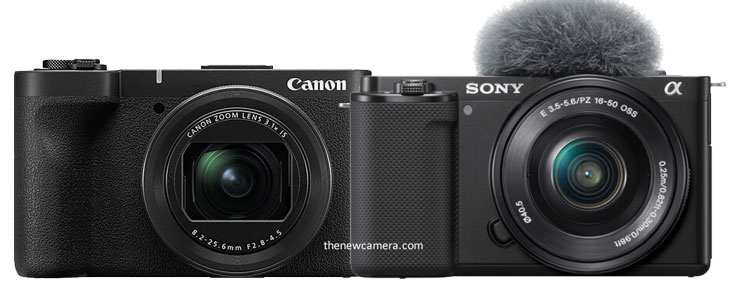
Conclusion / Verdict
Both cameras are made for content creators, but they approach different requirements fields. The Sony ZV-E10 camera gives you low-light flexibility and the opportunity to use a range of available lenses for E-mount. When that happens, you can create as much depth as you want to create cinematic footage by adding lenses like Sigma 30mm f/1.4 or Sigma 56mm f/1.4 in your ZV-E10 camera.
Now, Canon made the Canon V1 camera highly compact and highly portable with advanced video features like 4K 60 FPS recording with Log support. C-Log 3 is also available for color grading, and the camera records 10-bit video, so overall, it gives you flexibility and portability. The only thing that limits you in V1 is the low-light performance since it has a slightly smaller sensor than what you are getting in the Sony ZV-E10.
Another factor that differentiates between the two is the presence of an FSI sensor in Canon, whereas in Sony, we have the BSI CMOS sensor. So technically, in Sony, we will have a kind of better video quality, but again, we highly recommend the Canon V1 camera for lifestyle and travel bloggers.
Must Watch – Best Lense for Sony ZV-E10 Camera
A Canon V1 Camera is recommended for
Take a look at the specific work areas we are recommending the Canon V1 over the Sony ZV-E10 camera,
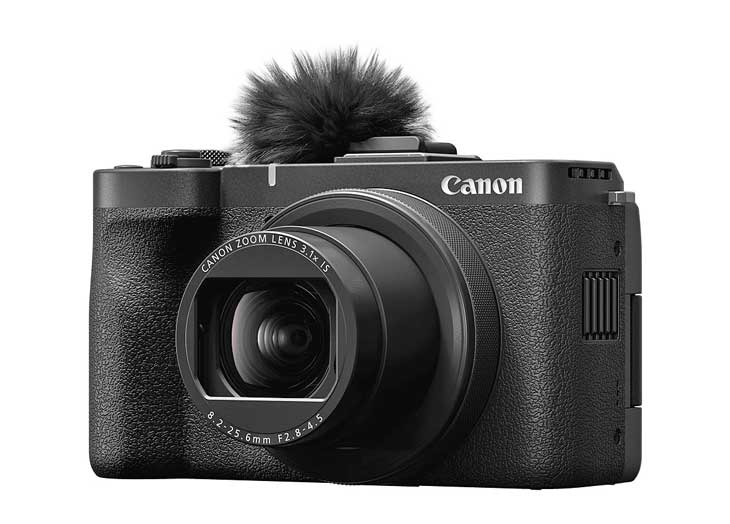
1. Lifestyle and Travel Bloggers
Now, this Canon V1 camera is perfect for travel bloggers or content creators who generally create lifestyle vlogs, hold their cameras in their hands, and are ready to go anywhere.
One of the biggest advantages that we should talk about with the Canon V1 is its portability, and the built-in fan is one of the major advantages of a compact camera.
Even if you are creating your vlogs in extremely hot and humid conditions, the built-in fan of the camera will keep the camera cool. At the same time, the camera enables Canon C-Log recording at 4K 30 FPS. You get a maximum of 5.7K oversampled video footage, so if you have a dedicated editor who can extract the maximum quality from this camera if you have the time and skill, then this camera is one of the best tools for travel bloggers or daily life content creators.
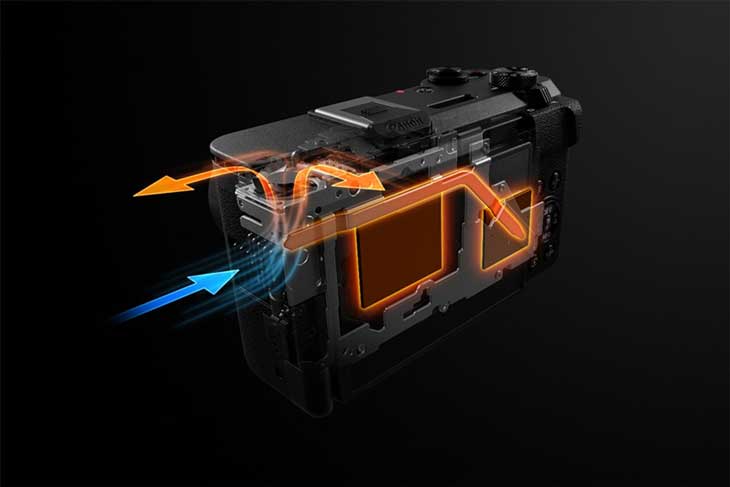
2. Canon V1 for Longer Video Recording
Another good use of the Canon V1 camera is creating long podcast videos as the camera will not overheat due to the internal fan present inside it. It supports using 4K 60fps for a prolonged time, although you are not able to use max aperture-based lenses—that’s the limitation we have. But when the priority is more important than the depth, it means the artist wants to record as long as possible from the camera, then we have no option.
Comparative Table: Key Specifications
| Feature |
Sony ZV-E10 |
Canon PowerShot V1 |
| Sensor Size |
APS-C, 24.2MP, 23.5×15.6mm |
1.4-inch, ~22.3MP, 18.63×12.42mm |
| Type of Sensors |
BSI |
FSI |
| Video Capabilities |
4K 30p (crop), Full HD 120p |
4K 30p full, 4K 60p (crop) |
| Log |
8 Bit, HLG, Slog2 and Slog3 |
10 Bit, CLog3 |
| Lens |
Interchangeable E-mount |
Fixed 16-50mm equiv., F2.8-4.5 |
| Autofocus |
Fast Hybrid AF |
Dual Pixel AF II |
| LCD |
3-inch vari-angle touchscreen |
3-inch vari-angle touchscreen |
| Audio |
Directional mic, 3.5mm jacks |
Stereo mics, 3.5mm jacks likely |
| Portability |
Larger, with lens |
Compact, highly portable |
| Battery Life |
~440 shots, NP-FW50 |
Extended with cooling fan, TBD |
| Stabilization |
IBIS or lens-based, varies |
5EV in-body image stabilization |
| Recording Time |
Limited by heat |
Extended with cooling fan |
| Connectivity |
Wi-Fi, likely Bluetooth |
Wi-Fi, likely Bluetooth |
| Ease of Use |
More controls, slight learning curve |
Simple, fixed lens, beginner-friendly |
| Price (Typical) |
$598 body, $698 with lens |
Expected $899 |
| Future Expandability |
High, with lens options |
Limited, fixed lens |
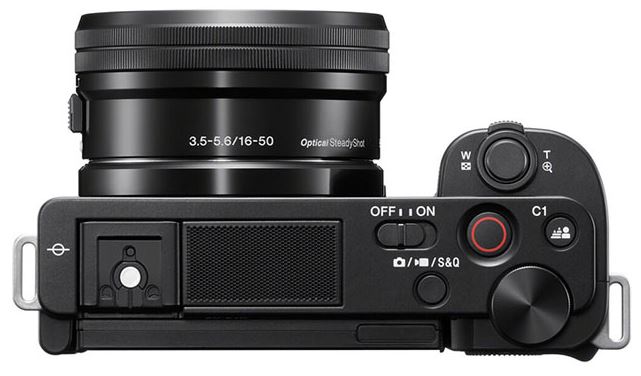
Reasons to buy the Sony ZV-E10 Camera
Take a look at the reason for selecting the Sony ZV-E10 camera over the Canon V1.
1. Freedom to select your LENS
The biggest reason for the selection of the ZV-E10 camera is lens flexibility. This is one of the major advantages associated with the ZV-E10. If you are creating talking head videos, then you can use a Sigma 30mm f/1.4 lens to have the best possible cinematic output for your content. And if you are creating handheld vlogs, then you can use lenses like Sony 11mm f/1.8 or the Viltrox 13mm f/1.4 to generate the best possible content even in low-light conditions with maximum possible cinematic depth.
That is the biggest freedom we have with the Sony ZV-E10 camera, but that comes with a price. You have to pay more and more for lenses depending upon your requirements for a camera.
 Sony ZV-E10 using VILTROX Lens
2. Gyro Image Stabilization
That’s an added advantage, and if you love to have completely stabilized videos in your camera, then the ZV-E10 is still a great option for you. But it’s not that easy. First, you have to capture the footage, then you have to apply it in Sony’s Catalyst Browse software.
Sony ZV-E10 Recommended for:
- Vlogging with high-quality stills: Its APS-C sensor + Interchangeable Lenses
- In-room / office Solo content creation Like product showcase mode make it suitable for solo creators.
- Low-light photography and video:
- Travel photography with interchangeable lenses: Lens flexibility allows for diverse shooting scenarios during travel.
- Customization and control for advanced users: More settings and More lens options
Canon PowerShot V1 Recommended for:
- Portability and simplicity: Ideal for users who prefer compact cameras with highest possible quality
- Advanced daily / Travel vlogging with 4K 60p and color grading:
- Documentary and travel videography
- Extended recording: Built-in FAN for a long podcast / outdoor shoot
- Street and candid photography: Best for street shoot with 4 STOPS of OIS
- On-the-go content creation: Highly portable, making it easy to carry for spontaneous shooting.
- User-friendly interface with fixed lens: Simple operation suits users who prefer not to deal with lens changes.
Price Consideration
Typically, the Sony ZV-E10 body only is priced at around $598, with a kit including a 16-50mm lens at about $698, while the Canon PowerShot V1 is expected at $899.
Sony ZV-E10 Amazon.com – B&H Store
By admin, on September 5th, 2024

Animal EYE auto-focus feature is now being added to the Sony ZV-E10 camera with the latest firmware 2.01 update. With this update, your camera will start auto-focusing and tracking animal eyes when recording a movie in 4K or Full HD, so that’s a welcome update for the Sony ZV-E10 camera.
Other features include the Sony touch Shutter function, which has been tuned up to perform more accurately. And finally, it has been noted that there are some operational stability fixes for the camera.
Download the latest firmware
Best Lenses for Sony ZV-E10 in 2024
Follow us on our social pages FACEBOOK | TWITTER | INSTAGRAM, If you have time –>see more Sony Alpha Rumor
By admin, on January 3rd, 2024
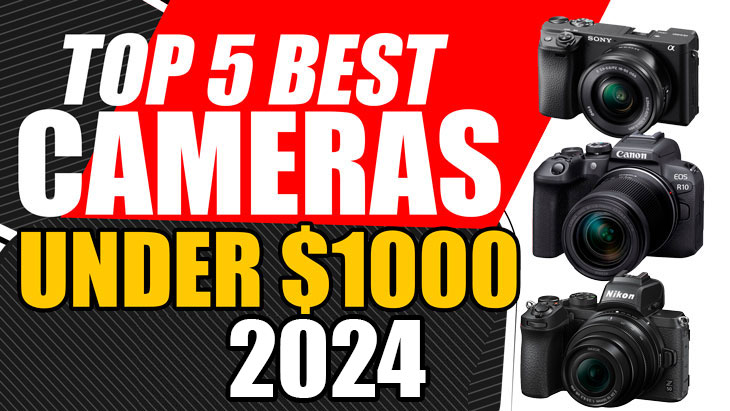
Take a look at the best mirrorless cameras of 2024, we have selected the best camera for your budget. Not only a camera for a specific area of interest we are recommending lenses also, without a proper lens u will never get a perfect output. So, always remember lenses are very important.
How to Select the Best Camera Under 1000 Dollars
Sensor Size
Image quality is a very important factor while selecting a camera. There are a lot of cameras with Micro Four Thirds format sensors, APS-C sensors, and even some full-frame sensor-based cameras present under the $1000 range.
However, one of the most important factors is not to buy a super outdated full-frame camera which is available for under $1000. If you buy a 5-year-old technology right now, then you will have very poor low-light performance with that particular full sensor. It’s highly recommended to buy the newest camera possible in the market so it will have the latest technology, and the best dynamic range possible. If you wish to buy a full-frame camera then of course there are options, but in that case, you have to care about the light situation when you are shooting, otherwise, you may have some issues with the older sensors. So mostly, we have selected some of the best available sensors, specifically those that are most updated and new for the buying guide.
Resolution
In limited sensor size, if the resolution of a camera sensor increases, at the same time the pixel per inch density increases, and hence the size of each pixel gets decreased. Buying a higher resolution camera, be prepared to have a good light setup. The higher resolution sensor will extract more details from a given scene but only if there is a presence of good light, otherwise, a lower resolution sensor will perform better compared to a sensor with high-density megapixels. So now you understand the balance, if you are working in a studio or controlled light environment you can buy a high-resolution camera. If you’re working in a low-light environment, you have to select a sensor with a lower MP count like Nikon Z50 or Z30.
Features
The features you get inside a camera depend upon the camera maker. Features include the ISO range of the camera, the continuous shooting speed capability, as well as the video quality of the camera. It depends on you, if you’re a sports photographer, you will mainly concentrate on the autofocus system of the camera as well as the continuous shooting speed. For those who are mostly inclined towards sports photography and want to have a fast shooting speed, they can have a Canon R10 camera which can shoot up to 15 frames per second with a mechanical shutter and up to 23 frames per second with an electronic shutter. And If you’re inclined towards videography under budget then you can have cameras like the Sony ZV-E10, one of the most capable cameras under $1000. You will save some bucks for having high-quality lenses and at the same time, if you want a camera that performs well, you can consider the Nikon Z30 and R50 cameras.
The selection of a camera depends upon your own set of requirements and the budget you have. If you are clear about your requirements, this guide will surely help you to get the perfect camera for your budget and your requirements.
Lenses
Finally, the lenses are the most important part of the camera. Without a perfect dedicated prime lens or a constant aperture-based zoom lens, you will have output from your camera similar to your smartphone. What I want to say is that if you’re planning to buy a camera with its kit lens, then for sure the output will disappoint you to some extent and you will feel the camera is capturing in the same manner as your smartphone captures. So it is highly recommended that if you’re planning to buy a mirrorless system camera of any brand, better to buy a camera body first and then decide the perfect lens for the camera. We have created several buying guides for each camera to have a perfect lens as per your requirement, so we are associating the lens guide too with each camera.
What are the Best Cameras in 2024?
|
Product |
Features |
Check Price |
|
Sony ZV-E10 |
- Best Vlogging Camera
- Budget-friendly
- Many Lenses available
|
 |
|
Nikon Z30 |
- #2 Option for Vloggers
- Excellent Low Light
- Budget-friendly
|
 |
|
Canon R10 |
- Best for Sports | Wildlife
- Also a Great Vlogging Tool
|
 |
|
Nikon Z50 |
- Low-light Beast
- For Wedding Photography
- For streets
|
 |
|
Sony A6400 |
- Best wedding Hybrid Camera
- Budget Wedding cinematography
|
 |
|
|
|
|
We have a new camera on our list, the Sony ZV-E10 Mark II. The Sony ZV-E10 Mark II is one of the best cameras available for content creators under the $1000 price range [Amazon.com | B&H Store] for the body only.
However, you will need to spend more on lenses; otherwise, the kit-less option is available at $1098 Price
Why should you spend more compared to the ZV-E10? The main advantage of the Sony ZV-E10 Mark II is that it has been recently announced by Sony and features 10-bit internal recording. With 10-bit internal recording, you are able to get the maximum dynamic range possible in this slot, which was not possible with the Sony ZV-E10 or any other camera. Even the Canon R10 does have a 10-bit recording option, but only in HDRPQ mode. So, the ZV-E10 Mark II has become the only camera in this place that offers 10-bit internal recording.
Other features include the ability to record 4K 60fps uncropped video. The Sony ZV-E10 Mark II is able to record 4K videos up to 60 frames per second without any crop. One of the best things about this camera is that it includes Product Showcase mode, Face Auto Exposure tracking priority mode, a dedicated internal microphone, a headphone port to monitor your audio, and in-camera image stabilization.
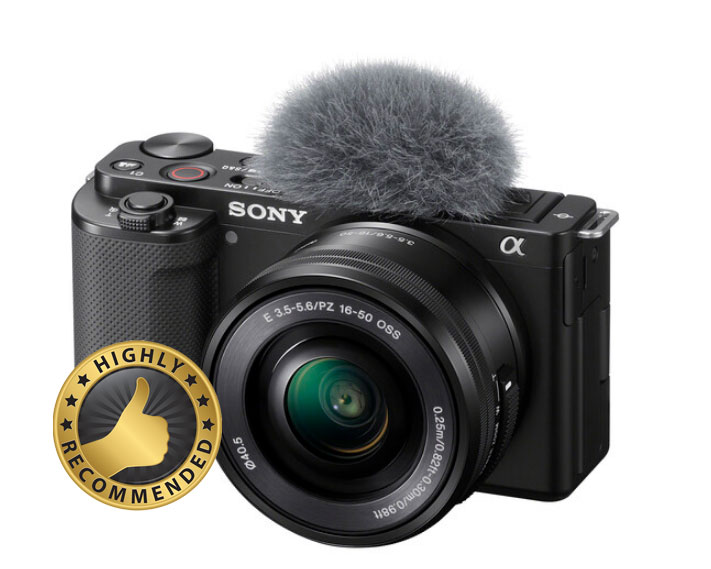
The best Camera right now is the Sony ZV-E10, the Sony ZV-E10 is even better than the Nikon Z30 since you have more range of available lenses to choose from, gyro-based Image Stabilization, as well as several features (3 capsule mics, product showcase mode, face exposure mode, and one-touch bokeh) for vloggers, the ZV-E10 camera makes vlogging easier.
Spend on some good Lenses – Best Lense for Sony ZV-E10 Camera
What people are saying after using ZV-E10 for more than a month
With this being my first camera, I chose an entry level option and this has turned out to be such an amazing upgrade from a cellular camera. Will definitely be buying more lenses for this camera! —–by matthew
The Sony ZV-E10 features a 24MP APS-C sensor, articulating selfie screen with touch capability, good quality oversampled and uncropped 4K/24p capture, headphone and microphone port, and a variety of add-on accessories to assist in video capture specifically aimed for bloggers or you can say a camera that’s really close to being a vlogger’s dream-camera, both in terms of price and feature set.
Sony ZV-E10 Pros and Cons
| Pros |
Cons |
- Compact size
- Articulating screen
- Great autofocus
- Supports add-on mic and headphone monitoring
- Works as a USB webcam
|
- Rolling shutter while panning
- In-camera charging slow for on-the-go use
|
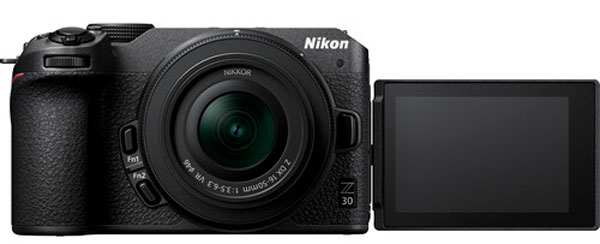
You can’t ignore the presence of the Nikon Z30, the camera uses the same 20 MP Excellent low-light sensor we have seen in cameras like Nikon Z50 and ZFC. If you are not in the mood to purchase the Sony ZV-E10 for some reason then the next best option is Nikon Z30, otherwise, always try to have the ZV-E10 first.
What people are saying after using ZV-E10 for more than a month
A simple camera that’s quite easy to use. The image quality is also quite nice. AF performance is top class
The Nikon Z30 is Nikon’s entry into vlogging world, the Z30 is a cut-down version of the Z50 model, with added vari-angle display screen, tally light, and 125-minute recording limit aimed at video content creators a cinematic video solution under budget.
Get Nikon Z30 from B&H Store | Amazon.com
Nikon Z30 Pros and Cons
| Pros |
Cons |
- Compact size
- Articulating screen
- Works as a USB webcam
|
- 28 min time limit on 4K to prevent overheating
- In-camera charging slow for on-the-go use
|
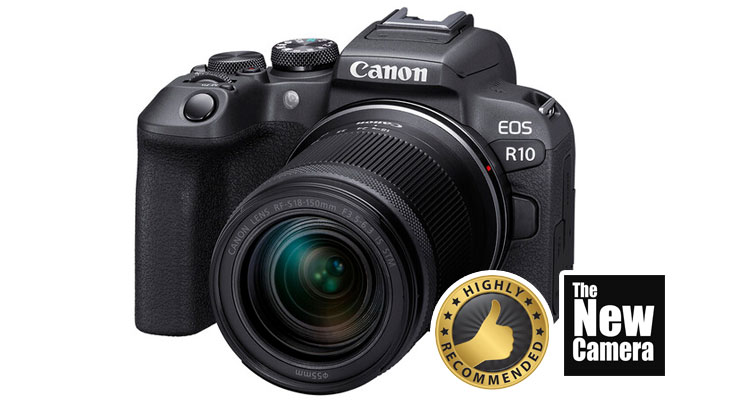
Canon R10 is the best camera for shooting sports or wildlife under a budget. Canon R3 uses the same AF Algo that’s being used in Canon R3, but due to hardware limitations (Sensor readout speed), the MAX burst speed is limited to 23FPS with full-time AF/AE support. The recommended budget lens for Wildlife and Sports is RF 100-400mm lens.
What people are saying after using Canon R10 for more than a month
I’m astonished that this relatively inexpensive camera has the same autofocus system found on Canon’s top of the line mirrorless cameras costing between five and six thousand dollars. This inclusion means that the chance of getting not just keeper images, but superb ones is much better than systems lacking such an advanced system. ……You can set the autofocus to track people, animals or vehicles for example. If set for animals, the autofocus is fast enough to track the eye of a bird in flight. The accuracy and speed of this camera have to be experienced to be appreciated. —- Paul
The only visible issue with the Canon APS-C system right now is a limited range of Lenses available for native RF Mount of cameras. Since Canon has a locked RF Mount and no third-party makers are allowed to make Canon Lenses.
Recommended for: Vlogs, Fashion, model portrait shoots, wildlife, and sports photography.
Canon R10 at B&H Store | Amazon.com
Canon R10 Pros and Cons
| Pros |
Cons |
- Compact and lightweight
- Impressive autofocus smarts
- Speedy burst mode
- Good value
- 4k 60p
|
- No in-body image stabilization
- Single card slot
- Locked RF-Mount
|
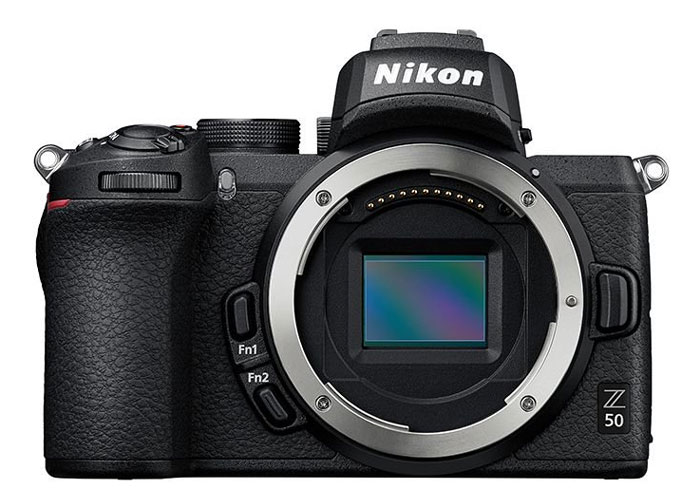
The Nikon Z50 is the first-generation Z-mount DX mirrorless camera, although with constant firmware updates, the camera is much improved compared to when it was announced.
Since the camera is made by a DSLR giant the ergonomics and user interface are generally very good, inside we have a modified D7500 sensor, a 20.9 MP DX Hybrid sensor with 209 Hybrid AF points, although the MAX shooting speed is limited to 11 FPS, the camera also has the ability to record high-quality 4K video at up to 30 FPS without any crop (Full HD slow motion at up to 120 FPS) and a compact, lightweight weather-sealed construction. A perfect camera for wedding & Event shooters as well as street shooters those who work with uncontrolled light environments.
What people are saying after using Nikon for more than a month
Surprisingly easy to use, feels good in-hand, and eye detect works great. For someone new to a ‘real camera’, this would be a great step into the advantages offered beyond the ubiquitous phone.
Really, about the only fault worth mentioning is the absence of in-camera image stabilization, but the in-lens IS does a great job in these kit lenses.—- Alan
The concerns – AF tracking of moving subjects is not as good as we see in Canon or Sony Cameras, lens availability isn’t that much issue in 2023 since we already have Tamron, viltrox, and sigma lens support now.
Recommended For: Wedding Photographers | Low-light / street photography | Wedding Video
Get Nikon Z50 from B&H Store | Amazon.com
Nikon Z50 Pros and Cons
| Pros |
Cons |
- Compact and lightweight
- Best for Lowlight
- Impressive autofocus smarts
- Good value
|
- No in-body image stabilization
- Single UHS I SD card slot
- Awkward flip-under selfie screen
|
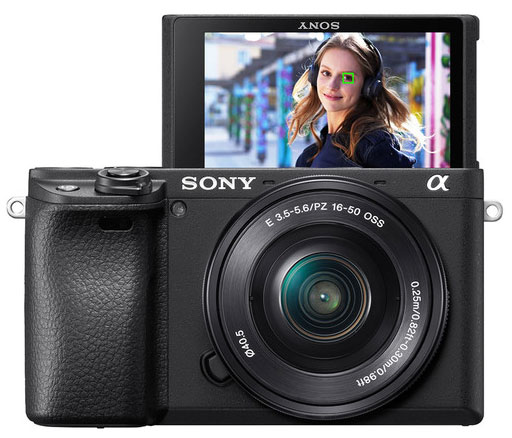
Sony A6400 is the best camera for wedding photography and video, with Sony A6400 u get a class-leading AF system, weather-sealed body, and support of a massive amount of third-party lenses.
For Wedding photographers and cinematographers the Sony A6400 is the best. For independent content creators, we already have cameras like Sony ZV-E10. The A6400 still image quality is very good, as well as the 4K video, which doesn’t have any recording limit, and the best part is the range of available lenses for the APS-C E-Mount. If you are a wedding photographer you can have lenses like Tamron 17-70mm F2.8 RXD Lens. One of the best candid lenses for APS-C cameras.
What people are saying after using Nikon for more than a month
This camera is outstanding. Even coming into 2023, it still holds its own against other cameras that cost 2-3 times the price. I purchased this camera along with a Sigma 56 mm lens, and together the two produce amazing 4k content. This was a great purchase.
Sony A6400 at amazon.com
Sony A6400 Pros and Cons
| Pros |
Cons |
- Compact and lightweight
- Quick, accurate autofocus.
- Selfie LCD and EVF
- Good value
- 4K video without recording limit.
|
- No in-body image stabilization
- Single UHS I SD card slot
|
By admin, on November 21st, 2023
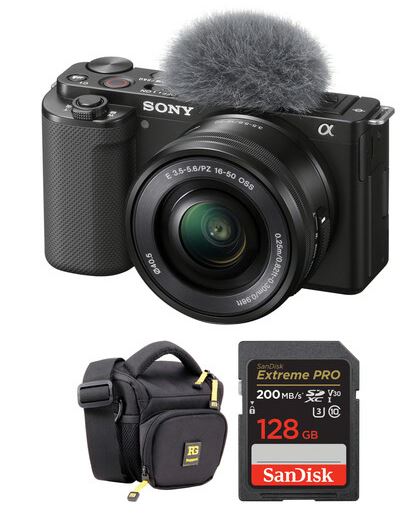
Check out the ZV-E10 Deals at B&H Here
Sony ZV-E10 Black Friday Deals at B&H Store| Grab the Sony ZV-E10 camera as there’s a special discount going on at the store. The store has not only given a $130 discount on the price of the camera, but they are also giving a 128 GB SanDisk card along with a free camera bag.

Get this DEAL at AMAZON.com
Sony ZV-E10 Black Friday Deals – at Amazon | Now, we have one more interesting deal for the Sony ZV-E10 camera for you at the official Sony Store and Amazon.com. Sony is offering you a 64GB memory card along with the camera bag, as well as a 4-set of essential filters for your camera completely free. So, this particular deal looks more promising and attractive to me compared to the previous one.
By admin, on February 9th, 2023
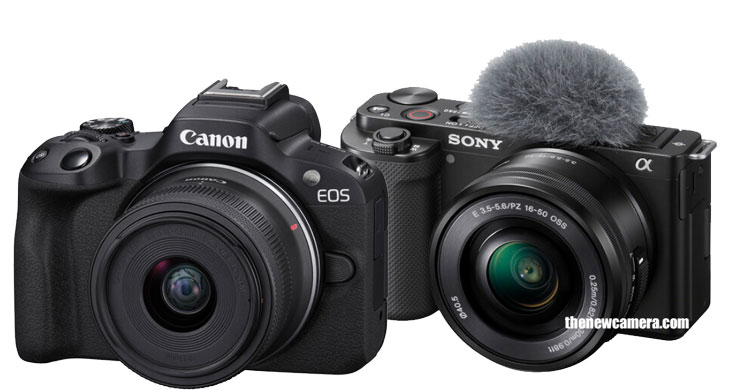
Let’s talk about the body design of both the camera the Canon R50 camera is more photographer friendly with the EVF and the deep hand grip that is missing in the Sony ZV-E10 camera
As you can clearly see Canon R50 and Sony ZV-E10 have different design approaches, Canon R50 has a more traditional, like a DSLR camera with a deep handgrip and also EVF for daylight shooting, while the Sony ZV-E10 may have a more modern, bit more compactish design that looks more vlogger friendly. Ultimately, the best camera for you will depend on your specific needs, shooting style, and set of available lenses (Open lens mount or close etc )
If you are a photographer and looking for a camera that has a more photographer-friendly design, it’s better to look up the Nikon z50 or maybe the Sony A6400.
But we have to also remember that the Canon RF mount supports a limited amount of lenses since it’s a closed mount and in Sony, we have an amazing range of lenses starting from the affordable to the g master series and the Sony lens amount of Sony is open from 2011. so literally, you have to be very conscious before making your decision
Get Canon R50 From Amazon.com | B&H Store
Get Sony ZV-E10 Camera from Amazon.com | B&H Store
| Lens Mount |
Canon RF |
Sony E |
| Sensor Resolution |
Effective: 24.2 Megapixel |
Actual: 25 Megapixel
Effective: 24.2 Megapixel (6000 x 4000) |
| Sensor Type |
22.3 x 14.9 mm (APS-C) CMOS |
23.5 x 15.6 mm (APS-C) CMOS |
| Crop Factor |
1.6x |
1.5x |
| Image Stabilization |
None (Video)
|
Digital (Gyro Based) |
| Built-In ND Filter |
None |
None |
| Capture Type |
Stills & Video |
Stills & Video |
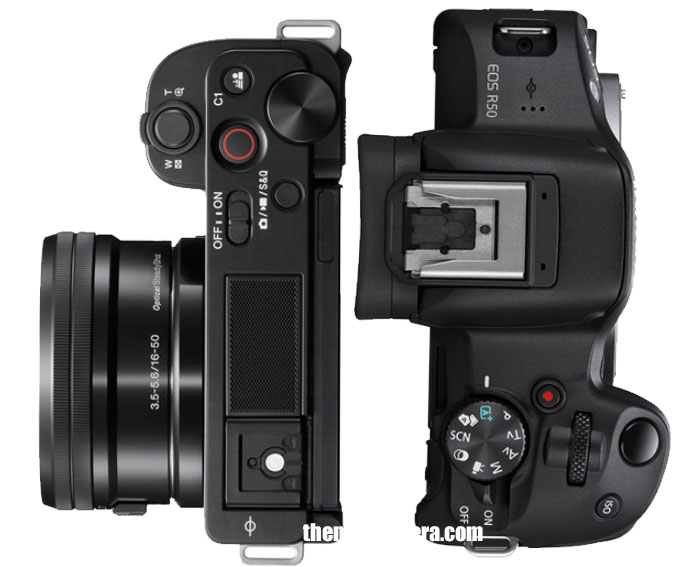
After the body design let’s compare the internal core specification of both cameras.
The Canon R50 camera features the same 24-megapixel sensor that we have seen in the Canon R10 camera, and also here the Sony ZV-E10 camera uses 24MP sensor, which we have seen in the Sony 6400 camera or A6600 camera.
| Shutter Type |
Electronic Shutter |
Electronic Shutter, Mechanical Focal Plane Shutter |
| Shutter Speed |
Electronic Shutter
1/8000 Up to 30 Seconds
Electronic Front Curtain Shutter
1/4000 Up to 30 Seconds |
Mechanical Shutter
1/4000 to 30 Seconds
1/4000 to 1/4 Second in Movie Mode |
| Bulb/Time Mode |
Bulb Mode, Time Mode |
Bulb Mode |
| ISO Sensitivity |
Photo/Video
100 to 32,000 (Extended: 51,200) |
Photo
100 to 32,000 in Auto Mode (Extended: 50 to 51,200)
Video
100 to 3200 |
| Metering Method |
Center-Weighted Average, Evaluative, Partial, Spot |
Center-Weighted Average, Multi-Zone, Spot |
| Exposure Modes |
Aperture Priority, Manual, Program, Shutter Priority |
Aperture Priority, Auto, Manual, Program, Shutter Priority |
| Exposure Compensation |
-3 to +3 EV (1/3 EV Steps) |
-5 to +5 EV (1/3, 1/2 EV Steps) |
| Metering Range |
-2 to 20 EV |
-2 to 20 EV |
| White Balance |
Presets: Auto, Cloudy, Color Temperature, Custom, Daylight, Flash, Fluorescent (White), Shade, Tungsten |
Presets: Auto, Cloudy, Color Temperature Filter, Custom, Daylight, Flash, Fluorescent (Cool White), Fluorescent (Day White), Fluorescent (Daylight), Fluorescent (Warm White), Incandescent, Shade, Underwater |
| Continuous Shooting |
Electronic Shutter
Up to 15 fps for up to 28 Frames (JPEG) / 7 Frames (Raw)
Electronic Shutter
Up to 12 fps for up to 42 Frames (JPEG) / 7 Frames (Raw) |
Up to 11 fps at 24.2 MP for up to 116 Frames (JPEG) / 46 Frames (Raw) |
| Interval Recording |
Yes |
Yes |
| Self-Timer |
2/10-Second Delay |
2/5/10-Second Delay |
AutoFocus Performancee
As you can see the number of AF points in Canon R50 is 4503 DPAF points for stills and 3713 DPAF points for Video. And when we compare it with the Sony’s ZV-E10 425 Hybrid AF points the comparison look meaningful less for a moment, but its not about how many numbers of AF points a camera has or fabricated inside it, the key factor of todays Mirrorless AF system in the Artificial Intelligent Algorithms inside the camera, and that’s the biggest reason why despite of having less number of AF points the AF performance of The Sony ZV-E10 is flawless.
| Focus Type |
Auto and Manual Focus |
Auto and Manual Focus |
| Focus Mode |
Continuous-Servo AF, Manual Focus, Single-Servo AF |
Automatic, Continuous-Servo AF, Direct Manual Focus, Manual Focus, Single-Servo AF |
| Autofocus Points |
Photo
Phase Detection: 4503
Video
Phase Detection: 3713 |
Phase Detection: 425
Contrast Detection: 425 |
|
|
-3 to +20 EV |
Canon R10 – Fastest Shooting Entry-level camera
For the first time Canon has introduced an electronic shutter inside an Entry level body, now with the help of an electronic setter we are able Burst upto 15FPSbut, but sadly the buffer is limited to 30 Frames of JPEG, so you can hardly have two second buffer slot with the Canon R50 Camera.
Sony ZV-E10 camera has a limited Brust speed of 11 frames per second, but at the same time the buffer memory of Sony’s ZV-E10 camera is much more than that of the Canon R50, with the ZV-E10 camera you are able to record 116 frames of JPEG in a single Brust and 46 frames of RAW0
Since Canon R50 camera uses a Canon R10 camera sensor and the samples of Canon R5 isn’t available right now, that’s why we are keeping the R10 image samples in our comparison list, so you can have an idea how will R50 will perform against the Sony ZV-E10
BASE ISO TEST

In the base are you so test you can clearly see both cameras are performing equally well, the detail capturing ability of both the camera is good at the base ISO range.
HIGH ISO TEST

Now let’s talk about the HIGH ISO TEST of both the camera, As now you can see the Sony ZV-E10 camera is able to preserve slightly more details in some specific situations compared to the Canon R50 Mirrorless camera, so for low light purposes of course Nikon ZV-E10 is bit more helpful.
Video Specs
| Internal Recording Modes |
H.264/H.265/MPEG-4
UHD 4K (3840 x 2160) at 23.98/25/29.97 fps
1920 x 1080 at 23.98/25/29.97/50/59.94/100/120 fps |
H.264/H.265/MPEG-4
UHD 4K (3840 x 2160) at 23.98/25/29.97 fps
1920 x 1080 at 23.98/25/29.97/50/59.94/100/120 fps |
| Broadcast Output |
NTSC/PAL |
NTSC/PAL |
| Built-In Microphone Type |
Stereo |
Stereo |

Best Entry-Level Camera to Record Videos?
Both cameras share exactly the same video Resolution and frame rates, Canon R50 camera as well as the Sony’s ZV-E10 camera records 4K videos up to 30 FPS and full HD videos up to 120 per second. So, for the first time, we have a Canon entry-level model that doesn’t crop in 4K. Undoubtedly it will bring smiles in face of Canon users, those who are waiting to upgrade their cameras from Canon M50 Mark ii or Canon 200D Mark II / SL3 . But, at the same time in 3rd generation of making APS-C Mirrorless cameras, the ZV-E10 is more video oriented and focuses on content creator requirements.
None of the cameras have any time recording limit in 4K 24 and 30 FPS recording video, but yes you have to carry extra battery packs says the batteries dry out quickly with these entry-level cameras when you are recording 4K.
Canon features DIGITAL Image stabilization mode in VIDEO, which we see generally in entry-level cameras, the mode works but with a cost of crop and it becomes unbearable and painful to your hands when you try to vlog with the Canon 18-45 kit lens, the 18mm wide generates a 24mm equivalent focal length of a full-frame camera and after that, once you apply Digital IS Mode, you hardly adjust yourself in the frame. So, if you want to vlog with an R50 camera, better to buy the Canon’s 15-30mm Lens OR at least an RF 16mm F2.8 Lens. But, unfortunately, the RF 16mm lens doesn’t have OIS Support. To better get the 15-30mm lens for vlogging if possible. As you know, we don’t have many options with Canon since the lens mount is locked and we have to select from a limited range of lenses.
Best lenses for Sony ZV-E10
But, the biggest surprise is we have a gyro image stabilization system inside the Sony ZV-E10 which works very effectively when you are shooting videos with the camera. Although using Gyro-based data is not that easy, either you have to use the catalyst browse software to stabilize your footage prior to editing, or Sony now also offers Catalyst plugin for premier pro software.
The range of available lenses is much more than you would expect, The Best Sony ZV-E10 Lens for Vlogging in 2023 is Sony 11mm F1.8 Lens, The lens captures a super wide 16mm full-frame equivalent look and a BRIGHT F1.8 aperture perfect for vlogging.
The Sony ZV-E10 also features a 3-capsule-based enhanced internal microphone design that captures audio much better than you would expect from a regular entry-level camera, as well as to monitor that audio you also get an extra 3.5mm headphone port. Which is not available with the Canon R50.
Of course, a Range of dedicated modes is also there which includes face exposure priority, product showcase, and skin softening mode for vloggers.
Interface
| Media/Memory Card Slot |
Single Slot: SD/SDHC/SDXC |
Single Slot: SD/SDHC/SDXC/Memory Stick Duo Hybrid (UHS-I) |
| Video I/O |
1 x Micro-HDMI Output |
1 x Micro-HDMI Output |
| Audio I/O |
1 x 1/8″ / 3.5 mm TRS Stereo Microphone Input on Camera Body |
1 x 1/8″ / 3.5 mm TRS Stereo Headphone Output
1 x 1/8″ / 3.5 mm TRS Stereo Microphone Input |
| Other I/O |
1 x USB-C Input/Output |
1 x USB-C Input/Output |
| Wireless |
2.4 / 5 GHz Bluetooth 4.2 Control |
1 x USB-C (USB 3.2 / 3.1 Gen 1) Input/Output (Shared with Power Input) |
| Mobile App Compatible |
Yes
*As of February, 2023: Check with manufacturer for the most up-to-date compatibility |
Wi-Fi, Bluetooth |
| Global Positioning (GPS, GLONASS, etc.) |
None |
None |
Best Camera for shooting Still Images and video?
Canon R50 overall design is more appealing to photographers since the camera also features EVF and a better handgrip, we also have an advanced AF system with AI AF object tracking mode and faster burst speed it looks ver impressive. But, at the same time you can see from the results of the High ISO Test, the Sony ZV-E10 sensor is preserving more details, if u want a more video-oriented camera with features like an advance microphone, dual 3.5mm jack, gyro-based IS, and product showcase mode, ZV-E10 best for you.
The Next BIG thing is Canon’s Locked lens mount. So, the range of lenses for an entry-level shooter is less (if you have a limited-budget lens ).
So, overall it depends upon who is buying the camera if he/she is a casual shooter. Not interested in having extra lenses and love the R50 design, then yes for you guys the R50 is best. But for those who are more serious with photography or video at the same time they have a limited budget, better to buy a Sony ZV-E10 camera (or A6400 is you are a photographer).
Get Canon R50 From Amazon.com | B&H Store
Get Sony ZV-E10 Camera from Amazon.com | B&H Store
|
KEEP THIS BLOG ALIVE - Support New Camera Buy Canon Lenses, Buy Music CD or Digital Camera at amazon it helps this site, and you do not pay anything extra, it is just a way to help support this site.

|



































